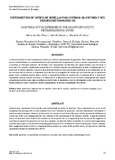| dc.rights.license | http://creativecommons.org/licenses/by-nc-sa/3.0/ve/ | |
| dc.contributor.author | Weisz, María del Mar | |
| dc.contributor.author | Nassar, Jafet M. | |
| dc.contributor.author | Pérez, Elizabeth M. | |
| dc.date.accessioned | 2014-05-15T09:51:05Z | |
| dc.date.available | 2014-05-15T09:51:05Z | |
| dc.date.issued | 2014-05-15T09:51:05Z | |
| dc.identifier.issn | 1012-1692 | |
| dc.identifier.uri | http://www.saber.ula.ve/handle/123456789/38503 | |
| dc.description.abstract | La oferta de semillas ha sido el método más usado en los estudios experimentales de granivoría. Estos experimentos presuponen que las semillas faltantes en cada tratamiento han sido consumidas por los granívoros, y que el consumo experimental es similar al consumo en situaciones naturales. No obstante, estos experimentos son afectados por algunos factores, que van desde la selección de las semillas a ofertar hasta la medición de la variable respuesta, que podrían poner en duda el cumplimiento de al menos uno de dichos supuestos. A pesar de las potenciales fuentes de error que puedan encontrarse en las estimaciones de las tasas de remoción de semillas, es importante tener una idea de la magnitud de semillas que son removidas por los granívoros porque dichas cantidades pueden llegar a afectar la disponibilidad futura de semillas para la regeneración de la vegetación. Ciertamente, muchos aspectos asociados a la estimación de la granivoría merecen ser revisados continuamente para obtener estimados más realistas; pero como se enfatiza en esta revisión, lo importante es que los investigadores estén conscientes de las posibles fuentes de error y ajusten los diseños experimentales en función de minimizar estos efectos. | es_VE |
| dc.language.iso | es | es_VE |
| dc.rights | info:eu-repo/semantics/openAccess | |
| dc.subject | Granivoría | es_VE |
| dc.subject | Depredación de semillas | es_VE |
| dc.subject | Remoción de semillas | es_VE |
| dc.subject | Métodos de exclusión | es_VE |
| dc.subject | Hormigas | es_VE |
| dc.subject | Aves | es_VE |
| dc.subject | Roedores | es_VE |
| dc.subject | Problemas metodológicos | es_VE |
| dc.title | Experimentos de oferta de semillas para estimar granivoría y sus errores metodológicos | es_VE |
| dc.title.alternative | Cafeteria-style experiments for granivory and its methodological issues | es_VE |
| dc.type | info:eu-repo/semantics/article | |
| dc.description.abstract1 | Cafeteria-style experiments have been the main methodology in studies of granivory. These experiments are based on the assumption that missing seeds in each treatment have been consumed by granivores, and that experimental consumption is similar to natural situations. However, in this review we examine several factors that may call into question the fulfillment of at least one of the cases, ranging from the seed selection to the measurement of the response variable. Despite the potential sources of error that can be found in the estimates of seed removal rates, it is important to have an idea of the magnitude of seeds that are removed by granivores because these amounts can affect the future availability of seeds for plant regeneration. Certainly many aspects associated with estimating granivory need to be constantly reviewed to obtain more realistic estimates, but as emphasized in this review, it is important that researchers are aware of the possible sources of error and so adjust the experimental designs to minimize these effects. | es_VE |
| dc.description.colacion | 75-85 | es_VE |
| dc.description.email | marweisz328@gmail.com | es_VE |
| dc.description.frecuencia | semestral | |
| dc.identifier.depositolegal | 198802ME173 | |
| dc.subject.keywords | Granivory | es_VE |
| dc.subject.keywords | Seed predation | es_VE |
| dc.subject.keywords | Seed removal | es_VE |
| dc.subject.keywords | Exclosures | es_VE |
| dc.subject.keywords | Ants | es_VE |
| dc.subject.keywords | Birds | es_VE |
| dc.subject.keywords | Rodents | es_VE |
| dc.subject.keywords | Methodological issues | es_VE |
| dc.subject.publicacionelectronica | Ecotropicos | |
| dc.subject.seccion | Ecotropicos: Artículos | es_VE |
| dc.subject.thematiccategory | Medio Ambiente | es_VE |
| dc.subject.tipo | Revistas | es_VE |
| dc.type.media | Texto | es_VE |


